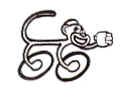MONDAY, AUGUST
21, 2000
songlines
and patterns

To paraphrase loosely the former
president whose face you are most likely to see in a
distant Eastern European villagerís shack or an Arab
emirís velvet art collection, "Ask not where you
can go in your city. Ask instead where your city can go
in you."
You would think the streets are
ultimately finite and that after twenty years they
should be cut, dried, and memorized, but it isnít that
way at all. Not long ago I discovered an elegant,
topographically, geographically, philosophically correct
shortcut that took me to India Basin from the mid-Bayshore
flats before Candlestick. Twice more that week the work
waves washed me down the same path. I wonder, as I sit
at home writing, when I will next ride that road again.
You donít have to be a bicycle
messenger to enjoy the patterns and secret winds of the
streets and neighborhoods. You just have to feel the
beat. I may not be way out on Clement or skirting the
hills on Alemany for six months in a row but sure
enough, when I do get to some seldom seen sector, I end
up back there, day or night, workday or weekend, about
three more days in a row.
It all comes down to streets and songs
and songs and streets. Bruce Chatwin, who died a couple
years ago, was a bon-vivant, adventurous, high society
type writer of fictional pieces, nonfiction essays, and
hard to sort out combinations of both. Sort of a Neal
Cassady for the Paul Theroux, Saul Bellow, Martin Amis
set. One of his most interesting books, a study of
aboriginal geographic realities in Australia, was called
"The Songlines." Songlines are very
sophisticated mapping systems used by natives of the
continent down under, which base distances and travel
instructions on traditional narrative songs handed down
from generation to generation. Instead of straight for
two miles and left at the 7-11, a songline instruction
would be more like, "Head the direction of the big
mountain and start singing a certain song; when you get
to verse 7, line 4, go right; keep going till the end of
the fourth chorus; hang a left and just before you get
to the end of the song youíll see Homeyís beer hut
on your left.
It wasnít long after I read this
book that I was happy to become conscious of my own
songlines tied to San Francisco streets. Although not as
precise and consistent as the system used by the native
Australians, certain favorite songs, snippets, and riffs
come up again and again as I ride around town trying to
avoid the consequences of some butthead breaking Newtonís
laws of physics on my shift.
Every now and then Iím pleased to
find I remember all the words to a song that made so
much sense standing by the road in 1981. Iím also
angered to notice I have ridden a block or two past my
destination to prove it! I guess Iíll have to be more
careful as I get older and spacier or Iíll find myself
groping for the last words of "Tommy" or
"Thick as a Brick" as I cruise past Brisbane
with a delivery that was destined for Dogpatch.
Streets and songs and songs and
streets. Some are trite and obvious: "Mission in
the Rain" when itís raining in the Mission,
"Aqualung" on Sixth street, and anything by
Chuck Berry on Berry. Some make less sense: Why
"When Doves Cry" at Beale and Folsom,
"Love My Way" at Eighth and Market, Beck songs
north of Broadway, Lou Reed South of Market, and Elvis
Costello in Pacific Heights? I sure donít know! In the
end itís always a San Francisco song in the singing,
isnít it?
Steel Monkey
Praise, positivity, invitations and
delicate questions can be sent to bjksf@wenet.net.
I am too psychologically frail to tolerate criticism or
negative feedback of any sort. Iíll let you know when
Iím ready for all that!